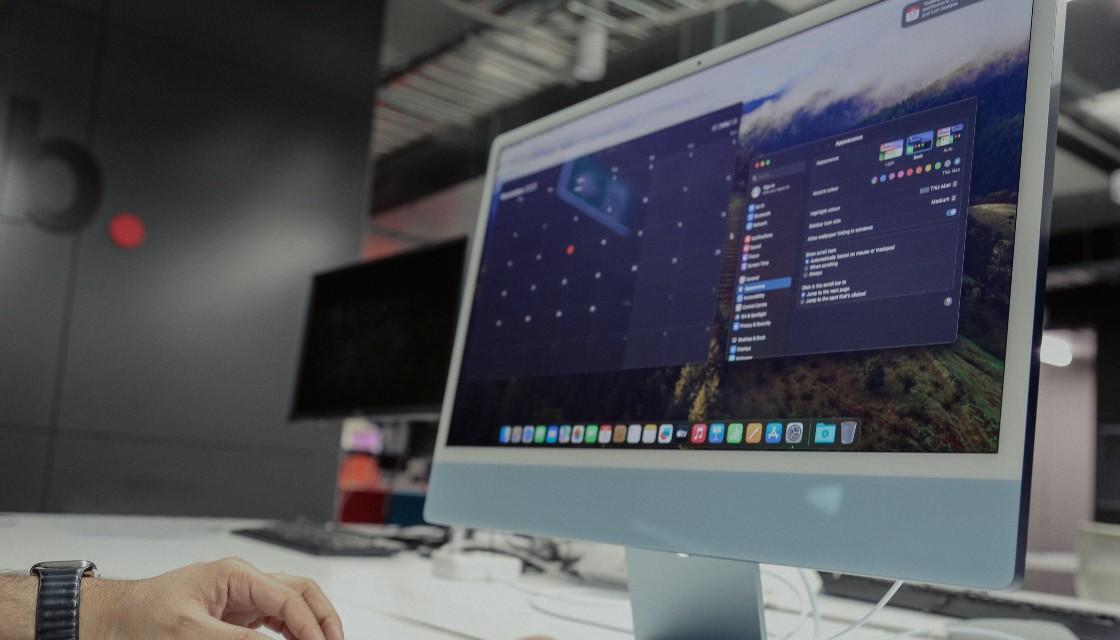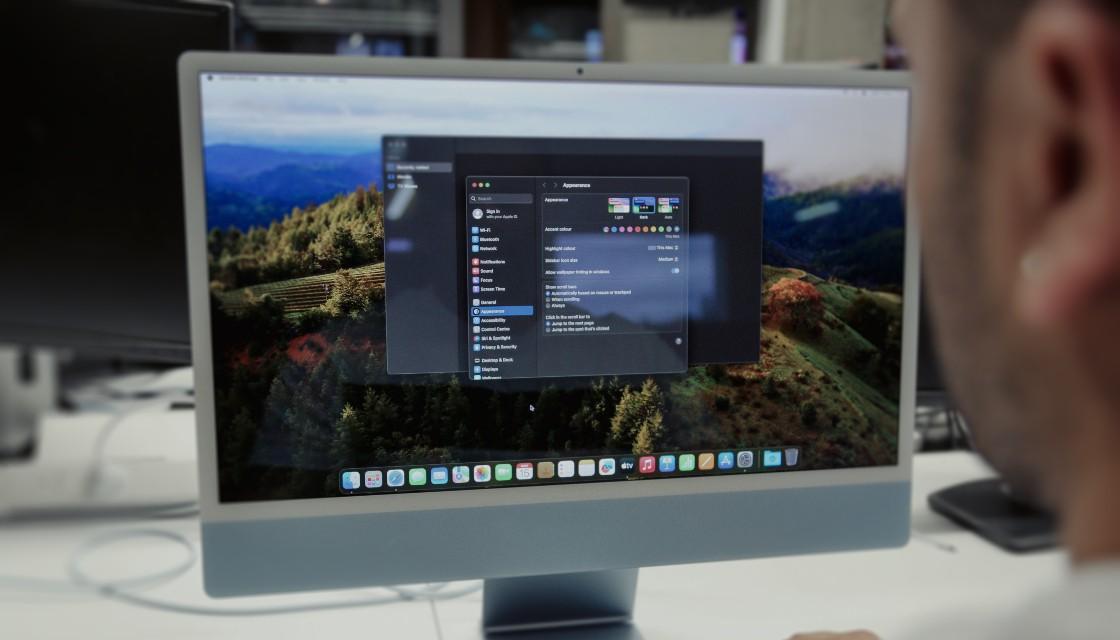
Apple's M3 powered iMac is a powerful, elegant device that makes an impressively complete package for everyday needs, but a lack of customisation and some frustrating design choices mean it keeps one foot in the past.
After spending a few weeks with the M3 as my primary computer, it makes a great case as an accessible 'all in one' device, despite not shining brightly enough in any category to make it an essential purchase.
However, for a family or young professional wanting a classy and compact computer, it's hard to beat the new iMac's combination of power, performance and slick design.
The outside

As a recent convert to the cult of Tim Cook, the form factor of Apple products still amazes me at every unboxing. The M3 iMac is sleek with a razor thin 11.5mm chassis and built-in stand, able to slot into home or office space with ease.
Even with the packaged trackpad, mouse and keyboard, the compact form factor makes for an effortlessly uncluttered home office. Weighing under 5 kilos, the iMac even transports easily between the home and office, straddling the divide between desktop and laptop.
Having transitioned to the iMac from a bulky gaming PC with two screens as my primary workstation, the simplicity of being able to plug it in anywhere, anytime and jump into work was welcome.
For those sold on its style but hoping to match the iMac to their decor, the range is available in seven colours: all look great but frustratingly, some of the splashier options - yellow, orange, pink, purple - are paywalled behind pricier models.
The 4.5K (4480 x 2520) Retina 24-inch display is gorgeous and maxes out at 500 nits, making it vibrant and bright enough to stand up to glare and looks great while gaming or streaming 4K content. The lock screen being a dynamic video, panning over rolling hills, is a lovely touch and makes going back to static lock screens on my other devices feel dull and dated.
Unfortunately, the screen's height is not adjustable and simply provides a tilt up or down. No ability to rotate either means while it will easily slot into a workspace, ergonomic options are lacking and you may need to stack a few books under it, particularly if you're at a standing desk.
Outside of the primary unit, one disappointment was the Magic Mouse, which I found an awkwardly slim size and not well suited to long sessions. Most frustratingly, its charging port is on the bottom, making it unusable while plugged in.
For a company famous for taking the concept of design and elevating it to an art form, it's baffling that this is somehow an unsolvable problem.
On charging, the iMac still makes use of lighting cables for peripherals instead of the switch to USB-C, which will likely not bother many users as we all still have a bunch of those cables lying around - but it does hold the iMac back from feeling like the 'all in one' of the future.
Elsewhere on peripherals, the base model iMac comes with two USB-C Thunderbolt 3 ports while the upgraded versions add two USB-C ports and an ethernet jack in the power block. This provides a decent amount of versatility but those with a lot of extra kit may end up using dongles.
Rounding out the package is an in-built webcam providing a crisp 1080p which pairs with six speakers capable of spatial audio and an expansive mic array. It's a perfect system for video conferencing and while the speakers might not reach the deepest bass during movies, they're impressive considering the tiny amount of real estate they're given in the chassis.
The inside

The biggest change internally for the iMac naturally comes from the new M3 chip, which as the iMac never received the M2 line, absolutely blows its predecessor away in terms of performance with more than twice the speed across the board.
The base model for $2499 comes with an 8 core GPU, a 256GB SSD and 8GB unified memory. The power of the M3 means this outfit will blitz through everyday use but in 2023, the limited storage means this will not be a feasible option for anyone wanting to work on large video projects locally or download more than a couple of games.
Moving up the ladder, there's the option of upgrading to 10 core GPU, 2TB SSD and 24GB unified memory. However, at this spec you'll be spending over $5000, at which point you may be better served by moving toward a more specialised machine.
This is a particular issue as the iMac doesn't include an upgrade option to use the M3 pro or Ultra chips found in the MacBook Pro, meaning for those wanting to do heavy video-editing and high-end gaming, it's hard to see how switching devices wouldn't give more bang for buck.
But outside of those specialised cases, the overall interface, powered by MacOS Sonoma, is snappy and responsive and I never experienced slowdown, even when bouncing between multiple tabs and some light gaming.
Apple claims apps like Excel and Safari work up to 30 percent faster on M3 and while I never benchmark-tested the basic apps, it feels safe to say not many people will be tempted into a new iMac to increase the speed of their spreadsheeting by a third.
In line with Apple's mission to be fully carbon neutral by 2030, the new iMac range also uses recycled magnets inside, recycled aluminium for its stand and completely recycled gold on its circuit boards. Considering the soaring need for these minerals as the whole world moves to roll out renewable technology, it's good to see Apple going green, even in gold.

Apple has made a dedicated push into gaming over the past year, bringing heavy hitters like Death Standing and Resident Evil onto IOS. The iMac's impressive display combined with the ability for live raytracing powered by the M3 make a solid case for it as a gaming PC, provided you aren't looking to run all games at max settings across the board and are okay with the still relatively limited library on offer.
That library did just get one significant addition however, with game of the year favourite Baldur's Gate 3 recently ported to IOS.
But another warning for those looking at base models with only 256GB in storage, as Baldur's Gate taking up 150GB: anyone seriously looking at the iMac as their primary gaming device will need to upgrade.
And while the 24-inch display is striking, the lack of a 27-inch option may put off some customers. For video-editing work, a larger screen is often a necessity and for gaming I found the 24-inch a little restrictive and missed my PC's second screen.
As far as second screens go, the iPhone is starting to fill that niche, with the iMac dialling up the integration between devices to allow widgets to share across screens. Texts and calls seamlessly appear on the iMac while working to minimise screen-switching, along with a universal clipboard allowing drag and drop or copy and paste between devices.
The verdict
The iMac is a sleek, elegant and impressive all-in-one computing package that will serve the everyday user extremely well.
However, a lack of extra powerful M3 chips, a relatively low-specced base unit when it comes to storage, and a few frustrating elements of design mean those looking for specialist use in any one area might be better served elsewhere.
Newshub was provided with an M3 iMac for this review.



